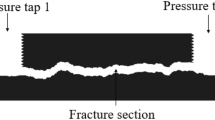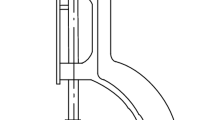Abstract
Conventional experiments using natural rock samples have trouble in observing rock structures and controlling fracture properties. Taking advantage of 3D printing technologies, a complex fracture network was made by using a 3D printer. This approach allowed us to control the properties of the fracture networks and to prepare identical geometries for both simulation and experiment. A tracer response curve from the flow experiment was obtained and compared with numerical simulations. The result of the computational fluid dynamics (CFD) simulation based on the Navier–Stokes equations was in good agreement with experimental result, which suggested that the results of experiment and the CFD simulation are reliable. On the other hand, comparison with an equivalent permeability model based on the cubic law showed a discrepancy from the experimental result. This validation approach enabled discussion of the limitation of the flow model. Because 3D printed fracture networks could reduce uncertainty between numerical simulation and laboratory experiment, they will be useful for understanding more detailed and more complicated phenomena in fracture networks.









Similar content being viewed by others
References
Adler, P.M., Malevich, A.E., Mityushev, V.V.: Nonlinear correction to Darcys law for channels with wavy walls. Acta Mech. 224(8), 1823–1848 (2013). https://doi.org/10.1007/s00707-013-0840-3
Ahrens, J., Berk, G., Law, C.: ParaView: an end-user tool for large data visualization. In: Hansen, C.D., Johnson, C.R. (Ed.) Visualization Handbook, pp. 717–732 (2005). http://www.paraview.org
Al-Yaarubi, A.H., Pain, C.C., Grattoni, C.A., Zimmerman, R.: Navier Stokes simulations of fluid flow through a rock fracture. Dynamics of Fluids and Transport in Fractured Rock, pp. 55–64. AGU, Washington (2005)
Bear, J.: Dynamics of Fluids in Porous Media. American Elsevier, New York (1972)
Bernabè, Y., Wang, Y., Qi, T., Li, M.: Passive advection-dispersion in networks of pipes: effect of connectivity and relationship to permeability. J. Geophys. Res. Solid Earth (1978–2012) 121, 713–728 (2016). https://doi.org/10.1002/2015JB012487
Brown, S.R.: Fluid flow through rock joints: the effect of surface roughness. J. Geophys. Res. Solid Earth (1978–2012) 92(B2), 1337–1347 (1987). https://doi.org/10.1029/JB092iB02p01337
Brush, D.J., Thomson, N.R.: Fluid flow in synthetic rough-walled fractures: Navier–Stokes, Stokes, and local cubic law simulations. Water Resour. Res. 39(4), 1085 (2003). https://doi.org/10.1029/2002WR001346
Cacas, M.C., Ledoux, E., Marsily, G., Tillie, B., Barbreau, A., Durand, E., Feuga, B., Peaudecerf, P.: Modeling fracture flow with a stochastic discrete fracture network: calibration and validation-1, the flow model. Water Resour. Res. 26(3), 479–489 (1990). https://doi.org/10.1029/WR026i003p00479
Dershowitz, W.S., Fidelibus, C.: Derivation of equivalent pipe network analogues for three-dimensional discrete fracture networks by the boundary element method. Water Resour. Res. 35(9), 2685–2691 (1999). https://doi.org/10.1029/1999WR900118
Erhel, J., De-Dreuzy, J.R., Poirriez, B.: Flow simulation in three-dimensional discrete fracture networks. SIAM J. Sci. Comput. 31(4), 2688–2705 (2009). https://doi.org/10.1137/080729244
Ge, S.: A governing equation for fluid flow in rough fractures. Water Resour. Res. 33(1), 53–61 (1997). https://doi.org/10.1029/96WR02588
Hakami, E., Barton, N.: Aperture measurements and flow experiments using transparent replicas of rock joints. In: Barton, N., Stephansson, O. (eds.) Rock Joints, pp. 383–390. Balkema, Brookfield (1990)
Hakami, E., Larsson, E.: Aperture measurements and flow experiments on a single natural fracture. Int. J. Rock Mech. Min. Sci. Geomech. Abstr. 33(4), 395–404 (1996). https://doi.org/10.1016/0148-9062(95)00070-4
Head, D., Vanorio, T.: Effects of changes in rock microstructures on permeability: 3-D printing investigation. Geophys. Res. Lett. 43, 7494–7502 (2016). https://doi.org/10.1002/2016GL069334
Hyman, J.D., Karra, S., Makedonska, N., Gable, C.W., Painter, S.L., Viswanathan, H.S.: DFNWORKS: a discrete fracture network framework for modeling subsurface flow and transport. Comput. Geosci. 84, 10–19 (2015). https://doi.org/10.1016/j.cageo.2015.08.001
Ishibashi, T., Watanabe, N., Hirano, N., Okamoto, A., Tsuchiya, N.: GeoFlow: a novel model simulator for prediction of the 3-D channeling flow in a rock fracture network. Water Resour. Res. 48(7), W07601 (2012). https://doi.org/10.1029/2011WR011226
Ishutov, S., Hasiuk, F.J., Harding, C., Gray, J.N.: 3D printing sandstone porosity models. Interpretation 3(3), SX49–SX61 (2015). https://doi.org/10.1190/INT-2014-0266.1
Javadi, M., Sharifzadeh, M., Shahriar, K.: A new geometrical model for non-linear fluid flow through rough fractures. J. Hydrol. 389(1), 18–30 (2010). https://doi.org/10.1016/j.jhydrol.2010.05.010
Jiang, Q., Feng, X., Song, L., Gong, Y., Zheng, H., Cui, J.: Modeling rock specimens through 3D printing: tentative experiments and prospects. Acta Mech. Sin. 32(1), 101–111 (2016). https://doi.org/10.1007/s10409-015-0524-4
Jing, Z., Richards, J.W., Watanabe, K., Hashida, T.: A three-dimensional stochastic rock mechanics model of engineered geothermal systems in fractured crystalline rock. J. Geophys. Res. 105(B10), 23663–23679 (2000). https://doi.org/10.1029/2000JB900202
Ju, Y., Xie, H., Zheng, Z., Lu, J., Mao, L., Gao, F., Peng, R.: Visualization of the complex structure and stress field inside rock by means of 3D printing technology. Chin. Sci. Bull. 59(36), 5354–5365 (2014). https://doi.org/10.1007/s11434-014-0579-9
Johnson, J., Brown, S., Stockman, H.: Fluid flow and mixing in rough-walled fracture intersections. J. Geophys. Res. Solid Earth (1978–2012) 111(B12), B12206 (2006). https://doi.org/10.1029/2005JB004087
Kang, P.K., Dentz, M., Borgne, T.L., Juanes, R.: Anomalous transport on regular fracture networks: impact of conductivity heterogeneity and mixing at fracture intersections. Phys. Rev. E 92(2), 022148 (2015). https://doi.org/10.1103/PhysRevE.92.022148
Konzuk, J.S., Kueper, B.H.: Evaluation of cubic law based models describing single-phase flow through a rough walled fracture. Water Resour. Res. 40(2), W02402 (2004). https://doi.org/10.1029/2003WR002356
Krantz, R.E., Frankel, A.D., Engelder, T., Scholz, C.H.: The permeability of whole and jointed Barre granite. Int. J. Rock Min. Sci. Geomech. Abstr. 16, 225–234 (1979). https://doi.org/10.1016/0148-9062(79)91197-5
Liu, R., Li, B., Jiang, Y., Huang, N.: Review: mathematical expressions for estimating equivalent permeability of rock fracture networks. Hydrogeol. J. 24, 1623–1649 (2016). https://doi.org/10.1007/s10040-016-1441-8
Long, J.C.S., Remer, J.S., Wilson, C.R., Witherspoon, P.A.: Porous media equivalents for networks of discontinuous fractures. Water Resour. Res. 18(3), 645–658 (1982). https://doi.org/10.1029/WR018i003p00645
Luo, J., Zhu, Y., Guo, Q., Tan, L., Zhuang, Y., Liu, M., Zhang, C., Xiang, W., Rohn, J.: Experimental investigation of the hydraulic and heat-transfer properties of artificially fractured granite. Sci. Rep. 7, 39882 (2017). https://doi.org/10.1038/srep39882
Min, K.B., Jing, L.: Numerical determination of the equivalent elastic compliance tensor for fractured rock masses using the distinct element method. Int. J. Rock Mech. Min. Sci. 40(6), 795–816 (2003). https://doi.org/10.1016/S1365-1609(03)00038-8
Mourzenko, V.V., Thovert, J.-F., Adler, P.M.: Permeability of a single fracture: validity of the Reynolds equation. J. Phys. II Paris 5, 465–482 (1995)
Neuzil, C.E., Tracy, J.V.: Flow through fractures. Water Resour. Res. 17(1), 191–199 (1981). https://doi.org/10.1029/WR017i001p00191
Oron, A.P., Berkowitz, B.: Flow in rock fractures: the local cubic law assumption reexamined. Water Resour. Res. 34(11), 2811–2825 (1998). https://doi.org/10.1029/98WR02285
Persoff, P., Pruess, K., Myer, L.: Two-phase flow visualization and relative permeability measurement in transparent replicas of rough- walled rock fractures. In: Proceedings 16th Workshop on Geothermal Reservoir Engineering, Stanford University, Stanford, California, January pp. 23–25 (1991)
Qian, J., Zhan, H., Zhao, W., Sun, F.: Experimental study of turbulent unconfined groundwater flow in a single fracture. J. Hydrol. 311(1–4), 134–142 (2005). https://doi.org/10.1016/j.jhydrol.2005.01.013
Renshaw, C.E.: On the relationship between mechanical and hydraulic apertures in rough-walled fractures. J. Geophys. Res. Solid Earth (1978–2012) 100(B12), 24629–24636 (1995). https://doi.org/10.1016/j.enggeo.2013.05.013
Sawada, A., Sato, H.: A study of hydraulic properties in a single fracture with in-plane heterogeneity: an evaluation using optical measurements of a transparent replica. NET 42(1), 9–16 (2010)
Schrauf, T.W., Evans, D.D.: Laboratory studies of gas flow through a single natural fracture. Water Resour. Res. 22(7), 1038–1050 (1986). https://doi.org/10.1029/WR022i007p01038
Smith, L., Freeze, R.A.: Stochastic analysis of steady state groundwater flow in a bounded domain: 2. two-dimensional simulations. Water Resour. Res 15(6), 1543–1559 (1979). https://doi.org/10.1029/WR015i006p01543
Snow, D.T.: A parallel plate model of fractured permeable media. Ph.D. Thesis University of California, Berkeley, USA (1965)
Suzuki, A., Niibori, Y., Fomin, S.A., Chugunov, V.A., Hashida, T.: Fractional derivative-based tracer analysis method for the characterization of mass transport in fractured geothermal reservoirs. Geothermics 53, 125–132 (2015). https://doi.org/10.1016/j.geothermics.2014.05.003
Suzuki, A., Watanabe, N., Li, K., Horne, R.N.: Fracture network created by 3D printer and its validation using CT images. Water Resour. Res. 53, 6330–6339 (2017). https://doi.org/10.1002/2017WR021032
Tsang, Y.W.: The effect of tortuosity on fluid flow through a single fracture. Water Resour. Res. 20(9), 1209–1215 (1984). https://doi.org/10.1029/WR020i009p01209
Tsang, Y.W., Tsang, C.F.: Hydrological characterization of variable-aperture fractures. In: Barton, N., Stephansson, O. (eds.) Rock Joints, pp. 423–431. Blkema, Rotterdam (1990)
Tsang, Y.W., Witherspoon, P.A.: Hydromechanical behavior of a deformable rock fracture subject to normal stress. J. Geophys. Res. 86(B10), 9287–9298 (1981). https://doi.org/10.1029/JB086iB10p09287
Tzelepis, V., Moutsopoulos, K.N., Papaspyros, J.N.E., Tsihrintzis, V.A.: Experimental investigation of flow behavior in smooth and rough artificial fractures. J. Hydrol. 521, 108–118 (2015). https://doi.org/10.1016/j.jhydrol.2014.11.054
Unger, A.J.A., Mase, C.W.: Numerical study of the hydro-mechanical behavior of two rough fracture surfaces in contact. Water Resour. Res. 29(7), 2101–2114 (1993). https://doi.org/10.1029/93WR0051
Yeo, I.W., De Fremitas, M.H., Zimmerman, R.W.: Effect of shear displacement on the aperture and permeability of a rock fracture. Int. J. Rock Mech. Min. Sci. Geomech. Abstr. 35(8), 1051–1070 (1998). https://doi.org/10.1016/S0148-9062(98)00165-X
Watanabe, K., Takahashi, H.: Fractal geometry characterization of geothermal reservoir fracture networks. J. Geophys. Res. Solid Earth (1978–2012) 100(B1), 521–528 (1995). https://doi.org/10.1029/94JB02167
Wilson, C.R., Witherspoon, P.A.: Flow interference effects at fracture intersections. Water Resour. Res. 12(1), 102–104 (1976). https://doi.org/10.1029/WR012i001p00102
Witherspoon, P.A., Wang, J.S.Y., Iwai, K., Gale, J.E.: Validity of cubic law for fluid flow in a deformable rock fracture. Water Resour. Res. 16(6), 1016–1024 (1980). https://doi.org/10.1029/WR016i006p01016
Zimmerman, R.W., Bodvarsson, G.S.: Hydraulic conductivity of rock fractures. Transp. Porous Med. 23, 1–30 (1996). https://doi.org/10.1007/BF00145263
Zimmerman, R.W., Yeo, I.W.: Fluid flow in rock fractures: from the Navier–Stokes equations to the cubic law. In: Faybishenko, B., Witherspoon, P., Benson, S. (eds.) Dynamics of Fluids in Fractured Rock. Geophysical Monograph, vol. 122, pp. 213–224. AGU, Washington (2000)
Zimmerman, R.W., Kumar, S., Bodvarsson, G.S.: Lubrication theory analysis of the permeability of rough-walled fractures. Int. J. Rock Mech. Min. Sci. Geomech. Abstr. 28, 325–331 (1991). https://doi.org/10.1016/0148-9062(91)90597-F
Acknowledgements
This work was supported by the Japan Society for the Promotion of Science under Grant-in-Aid for Young Scientists(A)(JP17H04976) and under Grant-in-Aid for Challenging Research (Exploratory)(JP17K19084) and Engineering and Physical Sciences Research Council (EPSRC) Bright IDEAS award: The Big Pitch (grant number EP/M016854/1), whose supports are gratefully acknowledged. Requests for numerical and experimental data should be addressed to Anna Suzuki (email: anna.suzuki@tohoku.ac.jp).
Author information
Authors and Affiliations
Corresponding author
Rights and permissions
About this article
Cite this article
Suzuki, A., Minto, J.M., Watanabe, N. et al. Contributions of 3D Printed Fracture Networks to Development of Flow and Transport Models. Transp Porous Med 129, 485–500 (2019). https://doi.org/10.1007/s11242-018-1154-7
Received:
Accepted:
Published:
Issue Date:
DOI: https://doi.org/10.1007/s11242-018-1154-7




